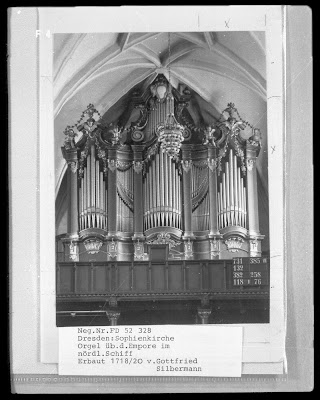Let's start with the Sophienkirche.
The story of this church started in the year 1272, when the Franciscans built a monastery (Franziskanerkloster) in the arounds of the city walls and what was to become the Dresden Castle. In the first half of the 14th century, the first structure was demolished, and a new, larger one was built, with the distinctive two choir areas.
Around 1541, in the time of the Reformation, the monastery was abolished and the Franciscans left the place. The building stood empty until it was reopened as a Lutheran church by Sophie of Brandenburg in 1610. In the following century, the Sophienkirche also became the city's Evangelical court church (Evangelische Hofkirche). Another change around the same time was the installation of a Silbermann pipe organ between 1718 and 1720, in which Bach probably performed (It shoud be noted that his son Wilhelm Friedemann was organist in the church from 1733).
Starting from 1864, the church configuration was modified - the baroque side tower was replaced by two neogothic spires and aisles were also added, although the Gothic nave from 1331 and the Busmannkapelle from the early 15th century remained with only minor modifications. The last prewar change were the copper-covered spires that from 1932-3 replaced the neogothic ones, which by that time were neglected because of the weather.
Although the church, like most of Dresden, was gutted by fire as a consequence of the devastating air raids of 13-15 February 1945, the main structure remained in a relative good condition (see this photo from 1960). Some elements, like the Nosseni and Sacristy Altars were salvaged, before the ruins of the oldest church in Dresden were blown up in 1962 under SED decree. The party chief Walter Ulbricht had commented before, "A Socialist city does not need Gothic churches!".
Starting from 2009, a memorial has been under construction. Resembling the Busmannkapelle, it's scheduled to be finished this year, although no project for the church as a whole has been planned yet.
Starting from 2009, a memorial has been under construction. Resembling the Busmannkapelle, it's scheduled to be finished this year, although no project for the church as a whole has been planned yet.
Other buildings like the Altstädtische Hauptwache were spared from total destruction. This structure was built by Joseph Thürmer following plans by Schinkel in 1830-32 as a guardhouse for the Royal Castle, located just across the street. After WW2, the city government decided to keep and restore the outer walls, although a new, modernist interior was built.
Last in this post, but not less important, is the Monument to King John of Saxony. Located in the center of the Theaterplatz, this memorial consists in a equestrian statue cast by Johannes Schilling in 1889.

very cool models!
ReplyDeleteThank you!
ReplyDeleteHallo Generalfeldmarschall,
ReplyDeleteIch hätte mal eine Frage. Ich interessiere mich sehr für ihr 3D-Modell vom "Dresden - König-Johann-Denkmal"
Könnten Sie es für mich zur weiterverarbeitung bei SketchUP bereitstellen???? Das wäre genail!!!!
Danke im Voraus!!!! :)
mfG. Chr.D.
Downloads are now avaliable for everyone at: http://sketchup.google.com/3dwarehouse/details?mid=7db43d4e98abd1f512fd706d7efde86d&prevstart=0
Delete